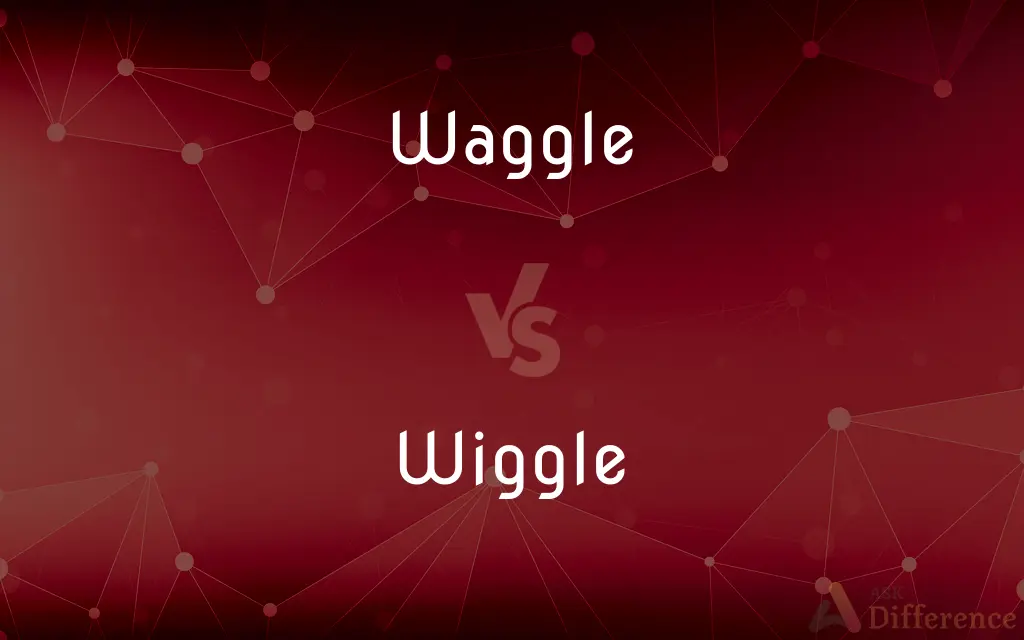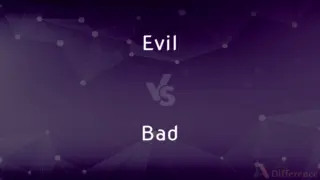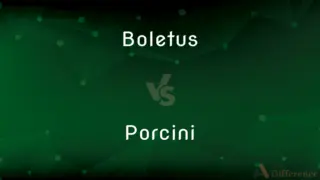Waggle vs. Wiggle — What's the Difference?
By Tayyaba Rehman & Urooj Arif — Updated on March 27, 2024
Waggle involves a side-to-side movement often with a specific purpose, while wiggle denotes a twisting or turning motion with more flexibility.

Difference Between Waggle and Wiggle
Table of Contents
ADVERTISEMENT
Key Differences
Waggle often refers to a deliberate side-to-side movement, like a golfer waggling their club before a swing, indicating a purposeful or preparatory action. On the other hand, wiggle is used to describe a broader range of twisting or turning movements, often connoting flexibility and ease, such as a child wiggling their loose tooth.
Waggle can be seen in various animals as a form of communication or display, such as bees waggling to share information about food sources. Whereas, animals wiggle for different reasons, including escaping from a predator’s grasp or simply to move in a tight space.
In human context, waggle might be used to describe a specific, often exaggerated, movement to attract attention or convey a message, such as a player waggling their eyebrows in a mock threat. Wiggle, however, often implies a playful or nonchalant movement, like wiggling one’s toes in the sand for pleasure.
Waggle has a connotation of being more controlled and less frequent in casual usage, often associated with specific actions or signals. Wiggle is perceived as more common and versatile, applicable to a variety of casual and playful scenarios.
Despite their differences, both terms highlight the importance of movement in communication and expression, demonstrating how even subtle variations in action can convey distinct meanings or intentions.
ADVERTISEMENT
Comparison Chart
Definition
A side-to-side movement with a specific purpose
A twisting or turning motion with flexibility
Common Usage
In deliberate or communicative actions
In playful or casual movements
Associated Actions
Golf swings, animal communication
Escaping, moving in tight spaces
Connotation
Purposeful, controlled
Playful, flexible
Examples
Golfer’s club, bee’s dance
Wiggling toes, a child moving in a seat
Compare with Definitions
Waggle
Deliberate Movement.
The golfer gave a final waggle to his club before taking the shot.
Wiggle
Flexibility.
The kitten managed to wiggle through the narrow opening of the fence.
Waggle
Attention-Getting.
She waggled her fingers above the baby’s crib to capture his attention.
Wiggle
Casual Adjustment.
She wiggled her glasses back into place with a quick movement.
Waggle
Animal Communication.
The honeybee performed a waggle dance to inform its hive of the food location.
Wiggle
Playfulness.
They couldn't help but wiggle to the catchy tune of the song.
Waggle
Sporting Actions.
The baseball player waggled his bat at the pitcher in a show of confidence.
Wiggle
Movement in Constraint.
Stuck in the tight seat, he could only wiggle slightly to get comfortable.
Waggle
Expressive Gesture.
He gave a quick waggle of his eyebrows to signal his agreement.
Wiggle
Indicative of Discomfort.
The child wiggled in his seat throughout the entire ceremony.
Waggle
To move (an attached part, for example) with short, quick motions
Waggled her foot impatiently.
Wiggle
To move back and forth with quick irregular motions
The gelatin wiggled on the plate.
Waggle
To move shakily; wobble
Waggled down the steps.
Wiggle
To move or proceed with a twisting or turning motion; wriggle
Wiggled restlessly in her chair.
Wiggled through the crowd.
Waggle
A wobbling motion.
Wiggle
To insinuate or extricate oneself by sly or subtle means
Wiggled out of a social engagement.
Waggle
(transitive) To move (something) with short, quick motions; to wobble.
Wiggle
To cause to move back and forth with quick irregular motions
Wiggle a loose tooth.
Waggle
(intransitive) To reel, sway, or move from side to side; to move with a wagging motion; to waddle.
Wiggle
To make (one's way, for example) by or as if by wiggling
The pitcher wiggled his way out of a jam.
Waggle
A wobbling motion.
Give the cable a waggle to let it come out quicker.
Wiggle
A wiggling movement or course.
Waggle
(golf) The preliminary swinging of the club head back and forth over the ball in the line of the proposed stroke.
Wiggle
To move with irregular, back and forward or side to side motions; To shake or jiggle.
Her hips wiggle as she walks.
The jelly wiggles on the plate when you move it.
Waggle
To reel, sway, or move from side to side; to move with a wagging motion; to waddle.
Why do you go nodding and waggling so?
Wiggle
(figurative) An alternating state or characteristic. en
Waggle
To move frequently one way and the other; to wag; as, a bird waggles his tail.
Wiggle
(in the plural) See wiggles.
Waggle
A waggling or wagging;
Wiggle
To move to and fro with a quick, jerking motion; to bend rapidly, or with a wavering motion, from side to side; to wag; to squirm; to wriggle; as, the dog wiggles his tail; the tadpole wiggles in the water.
Waggle
Causing to move repeatedly from side to side
Wiggle
Act of wiggling; a wriggle.
Waggle
Move from side to side;
The happy dog wagged his tail
Wiggle
The act of wiggling
Waggle
Move unsteadily or with a weaving or rolling motion
Wiggle
Move to and fro;
Don't jiggle your finger while the nurse is putting on the bandage!
Common Curiosities
How do animals use the waggle?
Animals, like bees, use the waggle as a form of communication, especially to indicate directions to food sources.
What does waggle mean?
Waggle refers to a deliberate side-to-side movement, often with a specific purpose or intent.
What does wiggle mean?
Wiggle describes a twisting or turning motion, characterized by its flexibility and often used in a playful context.
Is wiggling always playful?
While often playful, wiggling can also indicate discomfort or the need to adjust one’s position.
Can waggling attract attention?
Yes, waggling, especially exaggerated movements, can be used to attract attention or convey a message.
How do bees' waggles provide directions?
Bees perform a waggle dance in which the direction and duration of the waggle convey information about the distance and direction to food.
Can humans waggle?
Yes, humans can perform a waggle, often as an expressive gesture or in sports to convey confidence or readiness.
How do children use the wiggle?
Children often use wiggling as a way to express playfulness, discomfort, or simply to adjust their position.
Why do golfers waggle their clubs?
Golfers waggle their clubs as a preparatory action, helping them to loosen up and ensure a correct grip before a swing.
Is there a difference between a wiggle and a squirm?
Yes, wiggling is more general and often playful, while squirming implies discomfort or an attempt to escape.
Can waggling be used in competitive contexts?
Yes, in sports or games, waggling can be used to convey confidence or as part of a strategic bluff.
Can waggling be a form of communication?
Yes, waggling can serve as a non-verbal form of communication, particularly in sports or animal behavior.
Do all animals waggle for the same reason?
No, the reasons for waggling can vary among animals, from communication to attracting mates.
What signifies a playful wiggle?
A playful wiggle is often characterized by its spontaneous and light-hearted nature, such as wiggling to music.
Is wiggling a voluntary action?
Wiggling is usually a voluntary action, but it can also be a reflexive response to discomfort or tight spaces.
Share Your Discovery

Previous Comparison
Evil vs. Bad
Next Comparison
Boletus vs. PorciniAuthor Spotlight
Written by
Tayyaba RehmanTayyaba Rehman is a distinguished writer, currently serving as a primary contributor to askdifference.com. As a researcher in semantics and etymology, Tayyaba's passion for the complexity of languages and their distinctions has found a perfect home on the platform. Tayyaba delves into the intricacies of language, distinguishing between commonly confused words and phrases, thereby providing clarity for readers worldwide.
Co-written by
Urooj ArifUrooj is a skilled content writer at Ask Difference, known for her exceptional ability to simplify complex topics into engaging and informative content. With a passion for research and a flair for clear, concise writing, she consistently delivers articles that resonate with our diverse audience.















































